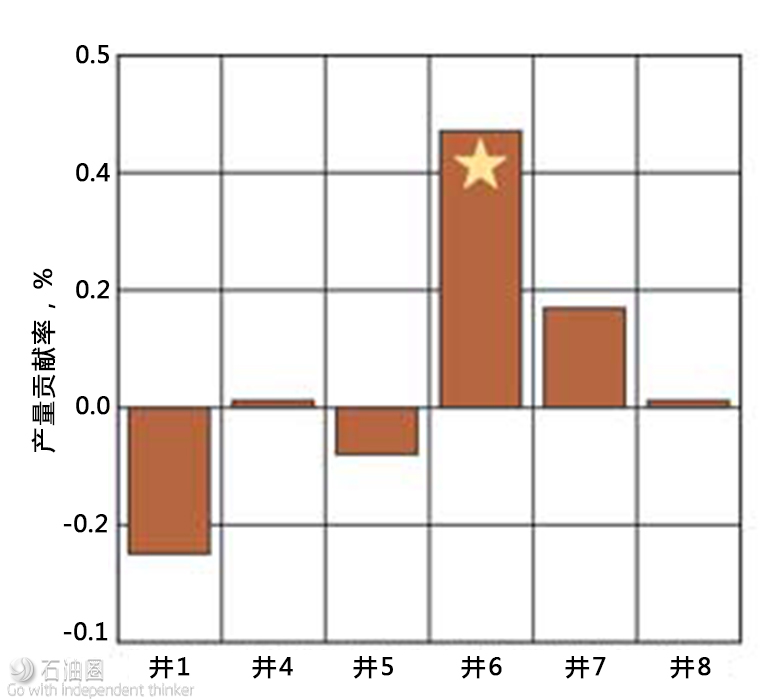Subsurface DNA diagnostics aid well spacing decisions in the Permian
HETEROGENEITY
Subsurface DNA markers display vertical and lateral heterogeneity stemming from geological and reservoir property variations. In the Wolfcamp shale, for example, hemipelagic sediments deposited during organic-rich deposition will have different microbial communities from thin calcareous turbidites and minor terrigenous inputs. This is due to differences in temperature, organic content, salinity, pressure, and pore size within the formation. These differences are great when examining the Bone Spring and Wolfcamp formations, where both geological and post-diagenetic processes impart unique subsurface DNA markers, which can serve as fingerprints.
Fig. 4. Vertical DNA Stratigraphy was assessed on a variety of scales, with the top 20 groupings colored. From left: formation-bar; family: DNA markers are grouped at a broad family taxonomic level, with each colored bar containing tens to hundreds of individual DNA markers; sequence: each color represents specific DNA markers; unique features: DNA markers that are only observed at a given depth; formation specific features: DNA markers found only within a specific formation.
A representative subsurface DNA log suite from a Delaware basin well (Fig. 4) summarizes DNA marker variation from more than 450 well cuttings samples taken at high spatial resolution along a single vertical wellbore. These data show variation at the sub-formation level of DNA markers, visualized as colored bars along the wellbore. These DNA logs can easily be integrated with other subsurface data, such as gamma ray, XRF, XRD, and other petrophysical measurements.
Unique and formation-associated features highlight those DNA markers only observed at specific depths or formations, thus enabling both intra- and inter-formation investigations, based on DNA markers. In addition, by visualizing the changes in DNA markers, identification of spatial patterns can be realized and integrated into subsurface workflows for seamless integration of subsurface DNA data with other subsurface measurements.
The use of well cuttings to create a higher-resolution view of subsurface heterogeneity is a key advantage of the new subsurface diagnostic tool and has enabled independent vertical drainage height estimates. Successful technology deployments through the Permian have involved collecting well cuttings from a vertical pilot well and applying this vertical DNA marker baseline to additional wells on the same pad.2,7 This successful project showcased that the formation end-members acquired from the vertical cuttings could be applied to wells on the same pad.
UPSCALING TO FIELD-WIDE DEVELOPMENTS
For field-level development, an important factor to understand is the spatial resolution of that vertical baseline signal. For example, how far away from a vertical baseline can the end-member, acquired from the cuttings, be compared to produced fluid without loss of signal?
Field trials in the Delaware basin have shown that lateral heterogeneity varies significantly, and robust sampling of produced fluid allows for calibration of the well cuttings signal through a field. Subsurface DNA markers observed in cuttings from the Wolfcamp B, for example, have been observed in wells landed within Wolfcamp B, providing support for using a single vertical baseline on other wells on a pad, given proper calibration and subsurface signal.
Localized variation has been observed during high-resolution characterization of vertical cuttings for 12 wells throughout the Permian. This speaks to the need for an integrated approach—basing end-member signals on a wide number of produced fluids, with well cuttings used as calibration—to better refine subsurface drainage height models. Furthermore, subsurface DNA findings have successfully been integrated with field-side data sets, such as production data, completions data (lateral length and proppant volume), thermal maturity, and basin models resulting in a multi-dimensional and robust understanding of the subsurface.
DETECTING FRAC HITS IN THE MIDLAND BASIN
The economic impacts of frac hits were recently reviewed, and the results showed up to 50% of a parent well’s production can be lost with a frac hit to a child well.8 This underpins the quest for optimized lateral spacing while minimizing well-to-well communication as another key driver in field economics. Ongoing monitoring of both parent and infill wells is needed to determine relative drainage and communication as field development progresses.
Fig. 5. During produced fluid monitoring in the Midland basin, six wells were possible culprits in a frac hit to well No. 2. Subsurface DNA was used to determine the relative contribution from each of these wells, and it was determined that well No. 6 was the most likely source.
Monitoring subsurface DNA in produced fluids at the pad-level can provide high-resolution diagnostics during fracturing and completion operations. In a published case study with EP Energy in the Midland basin, subsurface DNA markers were used to determine the well that caused a frac hit.9 As part of a deployment of the subsurface diagnostics within the southern Midland basin acreage, produced fluids from six wells were collected before, and during, completions and flowback operations. During the simultaneous frac operation of three child wells—well No. 4, well No. 5 and well No. 6—a pressure response was observed in a monitored parent well, which was well No. 2. The operator was unable to determine which child well was responsible for the pressure response. Subsequent simultaneous fracturing of wells 5 and 6 resulted in additional pressure response in well No. 2.
Subsurface DNA markers from well No. 2, before and after fracturing operations, were compared to the neighboring wells, to explore the similarity and extent of overlap of these DNA markers. Using data science analysis, a significant increase in predicted fluid contribution from well No. 6 was observed in parent well No. 2 after the frac operation, indicating that well No. 6 was the likely culprit of the pressure response, Fig. 5. This finding was later corroborated by the operator, eliminating well No. 5 as a possible suspect, due to the zipper frac effect. These findings led EP Energy to refine lateral spacing of wells to avoid a frac hit and monitor the connectivity of wells throughout time, to increase EUR of wells and improve the NPV section by several million dollars.9
CONCLUSION
Biota Technology has sequenced subsurface DNA from more than 10,000 samples, comprising more than 200 wells in the Permian basin. Through these investigations, subsurface DNA diagnostics have been shown to be a non-invasive and high-resolution tool for understanding reservoir properties and monitoring fluid production. These findings have been used to better understand out-of-formation contribution in Wolfcamp wells, and track production over various points in the life of a field, allowing for upscaling from pad-level to field-wide understanding.

 石油圈
石油圈


